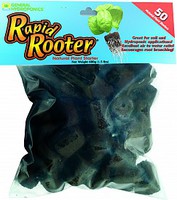
 Loading... Please wait...
Loading... Please wait...Save Money. Grow Your Own!
Fast Plain Box Shipping.
We ship to the US & Canada.
Posted on 21st Jun 2016
Spring onions, or green onions or scallions, or whatever you want to call them - these little plants are great for a hydroponic setup. In many cultures around the world, these small types of onions are a culinary delicacy on the grill. They are also a type of crop where you can grow a lot in a very small space.
Here's a how-to guide on an easy way to set up a hydro garden and grow spring onions in multiple plant cycles.
Start from Soil or Grow Media

While you can start the onion bulbs in a hydroponic setup, some growers also prefer to start them in the soil. You can simply cut a small furrow in the soil and insert bulbs, and then when they sprout, you can move them to the hydroponic facility. The one thing you'll need to do when transplanting the plants from soil is be sure to wash off any dirt or debris. That's because unlike most of the stuff used for hydro production, soil is not a sterile grow medium.
Set up your hydroponic system
Many growers like a simple tray table system for spring onions. The bulbs and roots will sit down in the water, and the green leafy stems will rise upward. Put together a tray table with nutrient-rich water, and put holes in the top of the tray for each plant. Fill with plants accordingly.
Let plants grow upward
Make sure there's plenty of space for the spring onions to grow upward. You also want to make sure you have adequate lighting -- if you're not using natural sunlight, make sure you have sufficient artificial grow lighting to allow plants to thrive. You may want to check the bulbs to make sure they're not getting too wet, otherwise they might rot or mold. Because it's a hydroponic setup, you probably won't have to spray with pesticides or herbicides.
Keep Checking on plants
In the middle of the grow cycle, you'll have some regular maintenance to do. Keep checking to make sure the temperature and humidity are in a good range. You also have to check pH value to make sure that it stays in a healthy range between 5 and 7. You might have to add pH value stabilizers during the process. You want to make sure that the nutrient water doesn't get too built up with solids.

At the same time, you want to be looking for any evidence of either insufficient lighting or plants burning when they get too close to lights. You also be looking for any evidence of bacteriological infiltration, which can harm plants.
Harvesting
As the spring onions get bigger and more mature, you can start thinking about taking them out and packing them up.
Some growers like to inject certain nutrient elements in the water in the final phase, either for taste, or to try to bulk up plants. This part is up to you, and you’ll get it right with trial and error over multiple plant cycles.
When it comes time to harvest, you want to find a way to store these vegetables well. Try bundling them with rubber bands and putting them in Ziploc bags. What you choose to do with this produce is up to you -- eat it, give it away to your friends, or try to sell some produce at a local farmers market or other venue.
That’s a basic step guide to getting these small, fresh, tastyonions into a hydro setup. Have fun!